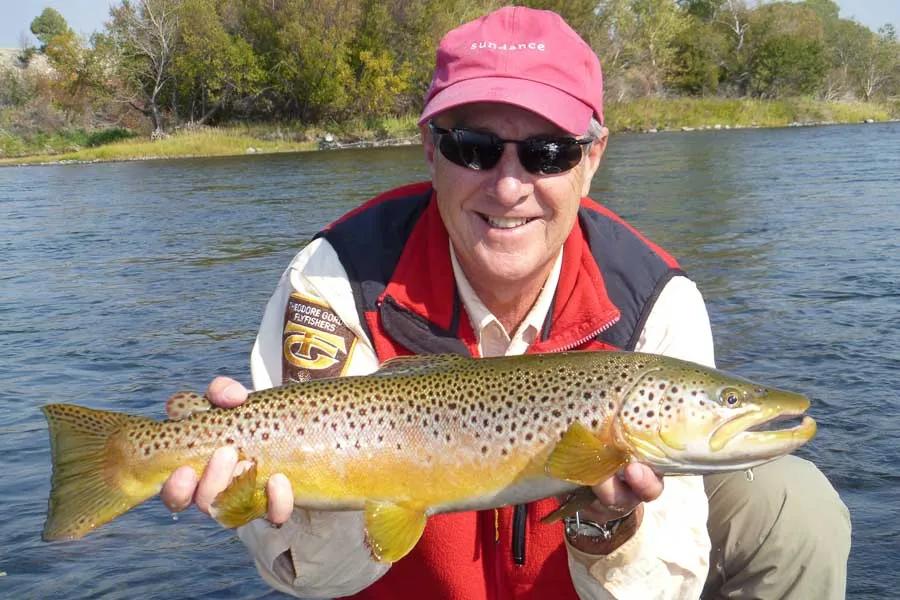
Fall may be the best time of year to fish the Madison river. The amount of angling pressure sharply drops, with kids back in school most of the tourists have left and a majority of the locals take to the woods to hunt deer and elk. As the temps drop and lead to cool nights and crisp mornings the water temperatures begin to drop. The drop in temps is welcomed by the trout that inhabit the river. A drop in water temperature also starts to activate the brown trout in the river to begin their spawning process. Some of the biggest fish in the river become much more active and aggressive. This is a time when some of the largest trout of the year are caught including a few in the 28-30” class. Fall also can provide some excellent dry fly fishing with beatis, midges and terrestrials. Here are 5 tips to improve your fishing on the Madison in the fall.
1) Try the lower river
The upper section of the Madison near Ennis gets most of the accolades and is by far the most famous and written about part of the river, the lower from Warm Springs to Three Forks also offers up some exceptional fishing.

The largest fish counts per mile are found where the river exits Bear Trap Canyon which leads to the greatest angling pressure. But during the fall this pressure is greatly alleviated opening up some excellent angling opportunity. The trick to the lower river is knowing when to fish it. Most summers the lower gets too warm to fish ethically leading to less publicity then the Upper reaches of the river. Come fall when the water temperatures come down making the lower river a great option. Despite the lack of fame compared to the upper river, it produces some of the largest trout in the river.
2) Fish bad weather
If you want to catch true trophy sized trout then you have to sacrifice some comfort. Fall in Montana can have a lot of variables when it comes to weather. It can be 80 degrees and sunny one day and then snow a foot the next and everything in between. One advantage you can give yourself is to fish in the bad weather. Snow/rain brings clouds, clouds and overcast make trout feel much more comfortable and more difficult prey for the raptors above. This means trout, especially large brown trout are more likely to be on the prowl for food on these days. Grabbing your 7wt and box of giant streamers can be an excellent choice. These are the days that the big boys are out and willing to play, swinging for the fences in hopes of a truly large trout can be the best strategy. This type of weather also helps to supercharge the fall beatis hatches and one can find themselves in the midst of a heavy hatch and numerous fish feeding off the surface. Luckily with advancements in the technology of clothing and materials with the right gear you can stay very comfortable in these adverse conditions.
3) Fish hoppers
Fishing with hoppers and other terrestrials can be very effective well into the fall, especially on milder years. With most of the summer hatches over hoppers can be the most successful way to fish on the surface. Typically there are still a lot of hoppers around up until the first hard freeze. Hoppers, ants, Beatles are all great options for the angler who wants to fish the surface.

Also all of these make for a big high calorie meal for trout and a lot of times can get some of the bigger trout to eat off the top. One of my favorite ways to fish large trout with hoppers in the fall is to try and sight fish them. I will work methodically to locate and sight where a good fish is holding and then try to entice the fish to rise to the hopper going over his head. Conversely to fishing with large streamers in bad weather, the gorgeous sunny October days of Montana can provide some excellent hopper fishing.
4) Fish bees
One of the most overlooked insects are bees. This is not one the most anglers think of when they think about “Trout Bugs”. But in early October bees and hornets get a little punch drunk and oftentimes find themselves stumbling into the water. The sudden cool down causes these bugs to slow down and can become an easy meal for trout. Once while fishing a small stream I saw over a hundred honey bees staggering around the bank and falling into the water. There are some bee fly patterns out there but a simple yellow double humpy is a great imitation. Next time you find yourself fishing the Madison on a warm October day try fishing a bee and you might be surprised at how productive that can be.
5) Fish the main runs
As air and water temperatures begin to cool, trout will move out of the side channels and quiet nooks of the river and move into more of the main runs. As water temps come down those shallower side channels will cool off quicker and trout will seek out more stable and consistent water temps, just a few degrees make all the difference for a trout. Focusing on the main runs of the Madison will increase your probability of finding fish and typically once you find one in an area there will be more. Also brown trout will begin to stage for the spawn, working large main runs with big nymphs trailed by beads is a very effective way to hook a fish of a lifetime in the Fall on the Madison.
